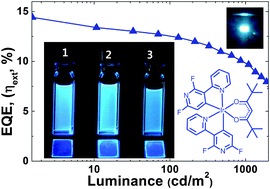Highly efficient blue phosphorescent and electroluminescent Ir(iii) compounds†
Abstract
Three new Ir(III) compounds with deep-blue phosphorescence have been synthesized. These molecules have the general formula of Ir(C∧N)2(L∧X), where C∧N =

* Corresponding authors
a
Division of Science Education, Kangwon National University, Chuncheon 200-701, Republic of Korea
E-mail:
kangy@kangwon.ac.kr
Fax: +82 33 242 9598
Tel: +82 33 250 6737
b
Department of Chemistry, Queen's University, Kingston, Ontario, Canada
E-mail:
suning.wang@chem.queensu.ca
Fax: +1 6135336669
Tel: +1 6135336941
c Department of Materials Science and Engineering, University of Toronto, Ontario, Canada
Three new Ir(III) compounds with deep-blue phosphorescence have been synthesized. These molecules have the general formula of Ir(C∧N)2(L∧X), where C∧N =

 Please wait while we load your content...
Something went wrong. Try again?
Please wait while we load your content...
Something went wrong. Try again?
Y. Kang, Y. Chang, J. Lu, S. Ko, Y. Rao, M. Varlan, Z. Lu and S. Wang, J. Mater. Chem. C, 2013, 1, 441 DOI: 10.1039/C2TC00270A
To request permission to reproduce material from this article, please go to the Copyright Clearance Center request page.
If you are an author contributing to an RSC publication, you do not need to request permission provided correct acknowledgement is given.
If you are the author of this article, you do not need to request permission to reproduce figures and diagrams provided correct acknowledgement is given. If you want to reproduce the whole article in a third-party publication (excluding your thesis/dissertation for which permission is not required) please go to the Copyright Clearance Center request page.
Read more about how to correctly acknowledge RSC content.
 Fetching data from CrossRef.
Fetching data from CrossRef.
This may take some time to load.
Loading related content
